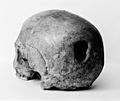Neurosurgery facts for kids
Neurosurgery is a very special kind of surgery that helps people with problems in their brain, spinal cord, and the many nerves that spread throughout their body. Imagine your body's control center and all its wires – neurosurgeons are the doctors who work on these important parts when they are sick or hurt. They use their skills to diagnose, treat, and even operate on these delicate areas to help people get better.
Contents
What is Neurosurgery?
Neurosurgery is a medical field focused on the nervous system. This amazing system includes your brain, which controls everything you think and do, your spinal cord, which sends messages between your brain and body, and all the nerves that reach every part of you. Neurosurgeons are like expert mechanics for this complex system. They learn for many years to understand how it works and how to fix it when things go wrong.
The Nervous System: Your Body's Control Center
Your nervous system is super important! It's made up of two main parts:
- Central Nervous System (CNS): This includes your brain and spinal cord. It's like the main computer and its central cable.
- Peripheral Nervous System (PNS): These are all the other nerves that branch out from your spinal cord to your arms, legs, and every organ. They are like the wires connecting the computer to all the different parts of a machine.
These nerves help you feel, move, think, and even breathe. When something goes wrong with them, it can cause serious problems.
What Do Neurosurgeons Treat?
Neurosurgeons help people with many different kinds of conditions. They treat problems that can affect anyone, from babies to older adults. Some common issues they handle include:
- Brain Tumors: These are growths in the brain that can press on important areas. Neurosurgeons can often remove them.
- Spinal Cord Injuries: Accidents can damage the spinal cord, affecting movement or feeling. Surgeons work to repair or stabilize these injuries.
- Herniated Discs: Sometimes, the soft cushions between your spinal bones (discs) can slip out of place and press on nerves, causing pain. Neurosurgeons can fix this.
- Aneurysms: These are weak spots in blood vessels, often in the brain, that can swell up. Neurosurgeons can repair them to prevent bleeding.
- Birth Defects: Some children are born with conditions affecting their brain or spinal cord, like spina bifida, which neurosurgeons can help correct.
- Nerve Problems: They also treat issues with nerves outside the brain and spinal cord, such as carpal tunnel syndrome, which affects nerves in the wrist.
How Neurosurgeons Work
Neurosurgeons use many tools and technologies to help their patients. They often use special microscopes during surgery to see tiny nerves and blood vessels. They also rely on advanced imaging like MRI (Magnetic Resonance Imaging) and CT scans (Computed Tomography) to get detailed pictures of the brain and spine before and during operations. Their goal is always to fix the problem while keeping the nervous system as safe as possible.
Becoming a Neurosurgeon
Becoming a neurosurgeon takes a lot of hard work and many years of schooling. After college, they go to medical school for about four years. Then, they spend another seven years or more in special training called a residency. During this time, they learn everything about the brain, spinal cord, and nerves, and practice performing complex surgeries under the guidance of experienced surgeons. This long training ensures they are highly skilled and ready to handle very delicate operations.
History of Neurosurgery
People have tried to treat brain problems for thousands of years. One of the oldest known surgical procedures is called trepanning, where a hole was made in the skull. Evidence of this has been found in ancient skulls from places like Edinburgh, showing that people tried to relieve pressure or treat head injuries even in ancient times. Of course, modern neurosurgery is much safer and more advanced, thanks to centuries of medical discoveries and new technologies. Today, neurosurgeons use incredible precision and knowledge to help people with conditions that were once untreatable.
Images for kids
-
Trepanned skull from Edinburgh.
See also
 In Spanish: Neurocirugía para niños
In Spanish: Neurocirugía para niños




